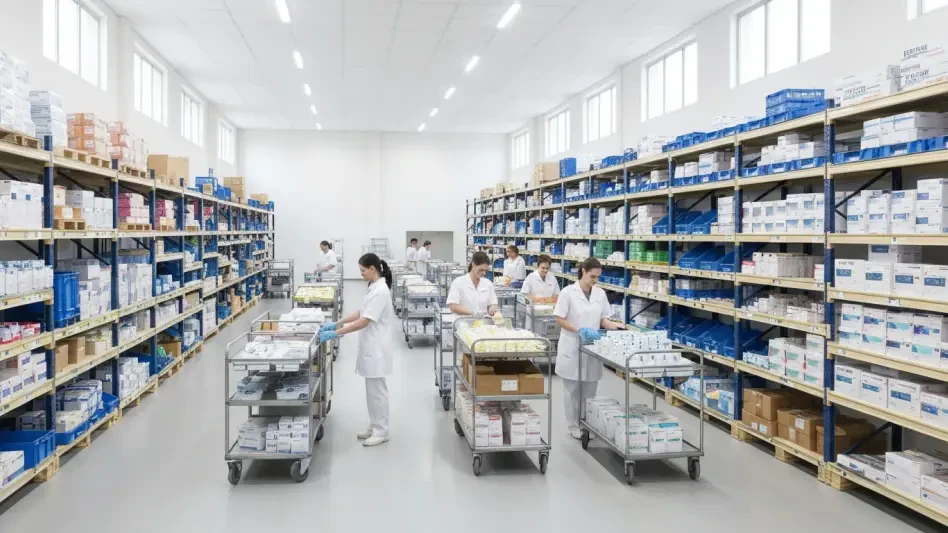Understanding the Healthcare Supply Chain Landscape
The healthcare supply chain stands as a vital backbone of patient care, ensuring that hospitals and clinics have uninterrupted access to essential products and services even under mounting pressures. This intricate network, responsible for delivering everything from life-saving medications to critical medical devices, plays a pivotal role in maintaining operational efficiency across the sector. Its ability to adapt to disruptions directly impacts the quality of care patients receive, making resilience a top priority for industry leaders navigating an increasingly complex global environment.
Spanning key segments such as pharmaceuticals, medical devices, and hospital supplies, the healthcare supply chain supports a multi-billion-dollar industry integral to global health outcomes. Major players like Johnson & Johnson, Pfizer, and Medtronic dominate the landscape, leveraging advanced technologies like inventory management systems to streamline operations. However, geopolitical factors, including tariffs, have introduced new challenges, disrupting traditional sourcing models and compelling organizations to rethink strategies for stability and cost control.
Beyond corporate giants and tech innovations, the supply chain’s significance lies in its direct connection to patient well-being. Disruptions can lead to delays in treatment or increased costs passed on to consumers, highlighting the urgency of addressing external pressures like trade policies. As tariffs reshape import dynamics, understanding the interplay of market forces and technological advancements becomes essential for stakeholders aiming to safeguard access to critical supplies.
Assessing the Impact of Tariffs on Healthcare
Emerging Challenges and Trade Policy Trends
Tariffs have emerged as a significant disruptor in the healthcare supply chain, adding layers of complexity to an already strained system. Recent trade policies, including a 15% tariff on medical devices imported from the European Union, have escalated costs for hospitals and manufacturers alike. Additionally, discussions around potential 200% tariffs on pharmaceuticals produced outside the U.S. or Europe threaten to further inflate prices, creating uncertainty for organizations reliant on global sourcing.
These trade disruptions exacerbate supplier dependencies, particularly for regions heavily tied to specific markets for raw materials or finished goods. Cost pressures from tariffs often trickle down to patients, who may face higher out-of-pocket expenses for treatments and medications. Moreover, the risk of supply chain bottlenecks increases as organizations grapple with sudden policy shifts, underscoring the need for robust contingency planning to maintain care delivery.
The broader trend of protectionist trade policies signals a shift toward localized production, though such transitions are neither quick nor cost-effective. Healthcare entities must navigate this evolving landscape, balancing immediate financial burdens with long-term strategic adjustments. The unpredictability of future trade agreements adds another dimension of risk, pushing leaders to prioritize flexibility in their operational frameworks.
Market Data and Cost Projections
Financial data reveals the tangible burden tariffs place on healthcare organizations, with early estimates suggesting cost increases of up to 10-15% for imported medical devices due to recent levies. Supply shortages, particularly for specialized equipment and certain drug components, have also been reported as manufacturers adjust to new trade barriers. These disruptions threaten to strain budgets already stretched thin by rising operational expenses.
Looking ahead, projections indicate that sustained tariffs could dampen market growth by 5-7% over the next few years if alternative sourcing strategies are not implemented. Long-term dynamics may see a shift in pricing structures, with hospitals potentially absorbing higher costs or passing them on to insurers and patients. This ripple effect could alter access to care, especially for underserved communities reliant on affordable medical solutions.
Analysts anticipate that trade policies will continue to influence strategic decision-making, with organizations likely to face increased scrutiny over cost management. The potential for escalating tariffs on pharmaceuticals could further complicate market stability, driving up expenses for chronic disease management. Stakeholders must remain vigilant, monitoring policy developments to anticipate and mitigate impacts on both financial health and patient outcomes.
Addressing Supply Chain Vulnerabilities
Healthcare supply chains face persistent vulnerabilities, including limited visibility into multi-tiered supplier networks that obscure potential risks. Over-reliance on specific geographic regions for critical materials heightens exposure to disruptions like tariffs or natural disasters. Many organizations still adopt a reactive approach to crisis management, addressing issues only after they arise rather than preemptively strengthening their frameworks.
Technological barriers compound these challenges, as outdated inventory systems hinder real-time tracking and decision-making. Cost pressures from tariffs further limit investments in modernization, creating a vicious cycle of inefficiency and risk. Without clear insights into supply chain dependencies, healthcare entities struggle to allocate resources effectively, leaving them ill-prepared for sudden trade policy shifts or other external shocks.
Proactive strategies offer a path forward, such as diversifying supplier bases to reduce reliance on single regions or markets. Enhanced risk assessment tools can help identify weak points before they become critical failures, enabling better planning. By investing in robust partnerships and contingency plans, organizations can build a buffer against disruptions, ensuring continuity of care even under adverse conditions like escalating trade tensions.
Navigating Regulatory and Policy Uncertainties
The regulatory landscape surrounding tariffs and trade policies remains in flux, creating a challenging environment for healthcare supply chain management. New rules often emerge with little warning, requiring rapid adaptation to avoid penalties or supply interruptions. Compliance becomes a moving target, as organizations must align with both domestic and international standards while managing cost implications.
Industry associations play a crucial role in navigating these uncertainties, offering guidance and advocacy to shape favorable policies. Collaborative efforts through such groups can amplify the sector’s voice, pushing for exemptions or relief from burdensome tariffs. Healthcare leaders are encouraged to engage actively with these bodies to stay informed and influence outcomes that protect patient access to essential goods.
Strategic partnerships, including group purchasing organizations, provide additional support by pooling resources and expertise to address regulatory shifts. These alliances can help negotiate better terms with suppliers or secure alternative sources amid trade disruptions. By fostering collaboration, healthcare entities can build a more adaptive response to policy changes, maintaining stability in an unpredictable regulatory climate.
Future-Proofing the Healthcare Supply Chain
Emerging technologies like artificial intelligence and predictive analytics hold significant promise for fortifying healthcare supply chains against tariff risks and shortages. These tools enable organizations to model potential disruptions, identifying high-risk areas before they impact operations. By leveraging data-driven insights, leaders can adjust purchasing strategies or secure backup suppliers proactively, minimizing delays in care delivery.
Market disruptors, such as a shift toward onshoring production, present both opportunities and challenges for long-term resilience. While bringing manufacturing closer to home may reduce exposure to international tariffs, the transition requires substantial investment and time, limiting immediate feasibility. Supplier diversification offers a more actionable near-term solution, spreading risk across multiple regions and partners to cushion against sudden policy impacts.
Innovation, coupled with cultural change management, will shape the future of supply chain resilience in healthcare. Encouraging a mindset of adaptability within organizations ensures that teams are prepared to pivot during crises. Global economic conditions will continue to influence strategies, but a commitment to technological advancement and forward-thinking planning can position the sector to withstand future uncertainties with greater confidence.
Conclusion: A Call for Proactive Resilience
Reflecting on the challenges posed by tariffs, healthcare organizations recognize the urgent need to transition from reactive crisis management to proactive supply chain strategies. The discussions highlight how vulnerabilities in supplier networks and regulatory uncertainties expose critical weaknesses, prompting a reevaluation of traditional approaches. This shift in perspective underscores the importance of preparedness over mere response.
Actionable steps emerge as a key focus, with an emphasis on educating teams about hidden risks and fostering visibility across operations. Strategic use of contracts to manage tariff exposure, alongside standardization efforts to unlock cost savings, provides practical avenues for mitigation. Empowering cultural change and adopting technologies like predictive analytics also stand out as vital tools that have begun to transform resilience planning.
Looking ahead, the opportunity to center supply chains in conversations about cost, quality, and access becomes a guiding principle. By integrating these elements into long-term strategies, stakeholders aim to ensure better outcomes for hospitals and patients. The path forward involves continuous collaboration and innovation, setting a foundation that can adapt to future disruptions beyond the immediate tariff landscape.









